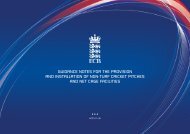ACO NEWSLETTER - Ecb - England and Wales Cricket Board
ACO NEWSLETTER - Ecb - England and Wales Cricket Board
ACO NEWSLETTER - Ecb - England and Wales Cricket Board
Create successful ePaper yourself
Turn your PDF publications into a flip-book with our unique Google optimized e-Paper software.
ScorersECB <strong>ACO</strong> Conference: Scorers ForumThe forum began with me updating those inattendance on the progress made since thelast conference regarding education <strong>and</strong> appointments.Of the 38 counties, 30 deliveredthe new Level 1 course during the winter of2011-12 <strong>and</strong> Level 1A assessments werestarted during the summer. The new Level 2course has been successfully piloted <strong>and</strong> willbe rolled out by the regions this winter <strong>and</strong>the new Level 3 course will be piloted thisautumn. Three new modules covering linearscoring, computer scoring using Total<strong>Cricket</strong> Scorer <strong>and</strong> Duckworth/Lewis arenow available on a regional basis. The ScorersInitiative, aimed at assessing existingscorers <strong>and</strong> recruiting them into the organisationhas been extended for a further year.Scorers wishing to progress along the pathwaywere encouraged to contact theirCounty or Regional Scorers’ Officers to findout about courses in their area <strong>and</strong> to encouragenon-member colleagues to comeOnce again, National Scorers Administration Officer, Geoff Trett, led theScorers’ Forum at the National Conference with 60-70 scorers from ECB<strong>ACO</strong>’s membership in attendance. Geoff has written the following report.forward for assessment.Moving to appointments, I reported thatthe range of opportunities is gradually increasing.This year, in addition to the MCCcorporate sixes <strong>and</strong> MCC Universitiesteams which we have supported in the past,we have made appointments for the MCCYoung <strong>Cricket</strong>er Ladies team, a <strong>Cricket</strong>erCup semi-final, have suppliedDuckworth/Lewis managers for the latterstages of the Kingfisher Cup <strong>and</strong> helpedCricHQ develop their software by findingscorers to help with testing in real game situations.For scorers looking for wider experienceor multi-day cricket, County age-groupyouth <strong>and</strong> academy matches were recommended,which are proliferating <strong>and</strong> oftenneed scorers – either contact your CSO orCounty <strong>Cricket</strong> <strong>Board</strong> for more information.We then widened the discussion to thefloor. With Duckworth/Lewis becoming increasinglyprevalent in league cricket, wewere fortunate to have scorers who haveused D/L in the Surrey Championship <strong>and</strong> inEurope <strong>and</strong> they shared their experienceswith us. Basically, these have been positive– it is important for scorers <strong>and</strong> umpires tobe trained in the use of the system in advance.Scorers had either deployed additionalscoreboards or had used fields onexisting scoreboards e.g. “last man” to showD/L targets at the end of each over. Clubsneed to have a printer available to print outthe relevant tables. The players had all welcomedthe innovation; in Northern Irel<strong>and</strong>Duckworth/Lewis is being cascaded downthe leagues in response to player request. Itwas encouraging to hear such positive reportsfrom scorers as I’m sure a lot more ofus will be using this system in the years tocome.We also had a debate about the paymentof scorers in league cricket. A straw poll indicatedthat a lot of scorers present do notreceive remuneration for league cricket <strong>and</strong>are quite content with that situation – althoughthey feel that payments for higherlevels of cricket are appropriate. There weresome scorers present who do receive someform of payment for league cricket – thisranged from travelling expenses to paymentsof up to £25-£30 per match. Practices clearlyvary in different parts of the country <strong>and</strong> itwas interesting to hear an update on thissubject from the good cross-section of scorersrepresented at the meeting.Earlier in the conference, Nick Cousinshad stated that retention of new membersafter their initial free year had been a problem<strong>and</strong> we briefly discussed the reasons behindthis for scorers. We are looking at waysto try <strong>and</strong> get leagues to help with scorer retention<strong>and</strong> ECB <strong>ACO</strong> membership, but thiswork is still in its very early stages.Overall a very positive <strong>and</strong> constructivediscussion <strong>and</strong> I’d like to thank everyone forcoming along <strong>and</strong> taking an active part.Response to queries on the application of the D/L methodThe following discussion relates to points made in this email message.Recent rain-affected CB40 matches have revealeda critical weakness in the Duckworth-Lewis system which systematically favoursthe team batting second.The Derbyshire versus Nottinghamshiregame this season typifies the problem.Derbyshire lost 4 early wickets <strong>and</strong> hadclearly embarked on a re-building exercisewhen rain intervened after 13 overs of theirinnings with Derbyshire on a score of 48.When the game re-started it was reducedto a 14 over match, which left Derbyshirethrowing the bat for a mere 6 balls. Nottinghamshirewere then given a meagre 67 runsto win off their 14 overs by Duckworth-Lewis. The outcome was so certain that theyneedn’t have batted.This is typical of many early rain-affectedmatches in which the team batting second isalmost certain to be victorious.I would therefore propose an amendmentto the Duckworth-Lewis calculation in suchcircumstances, which links the target set forthe team batting second directly to the numberof wickets they lose in the chase.Take the match above to illustrate the proposedamendment:48 for 4 after 13 overs before the rain:• Assemble the matches (set A) in whichteams batting first passed through this exactsame score (48 for 4) in rain-unaffectedmatches• Calculate the average total runs at 40 oversof this set of scores – this would represent afair target for the team batting second ifthey were to have 40 overs to bat with 10wickets in h<strong>and</strong>.• Now take all matches unaffected by rain(set B) & assemble all first innings scoresafter 13 overs.• Take all matches with 0 wickets lost after13 overs & calculate the lowest score (s0)at 13 overs above which the 40-over targetwas exceeded more times than it was notachieved in these matches.• Repeat this for 1, 2, 3, 4, 5, 6, 7, 8, 9 wicketsat 13 overs – to set s1, s2, …. to s9 respectively• The team batting second should then be issuedwith a Table of the 10 targets (s1 tos9) after 13 overs – one for each of 0, 1, 2,3,4, 5, 6, 7, 8, 9 wickets lost”This will have the effect of conditioning thetarget by the number of wickets lost, <strong>and</strong> willconstrain the team which currently is allowedall 10 wickets to achieve what is usually ameagre target.”Duckworth <strong>and</strong> Lewis responseA bias to Team 2?The first assertion by the correspondent relatesto an alleged bias to Team 2 in interruptedmatches.continued on page 30e-mail us at ecbaco@ecb.co.uk 28 contact us on 0121 446 2710



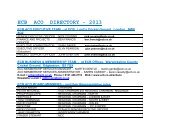
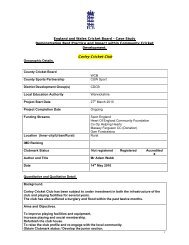
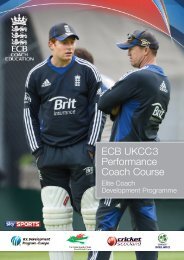

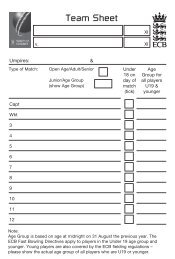
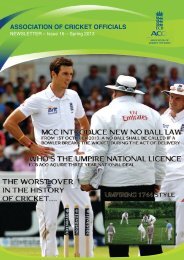
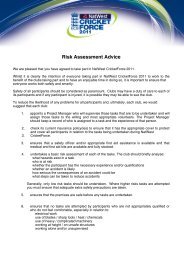
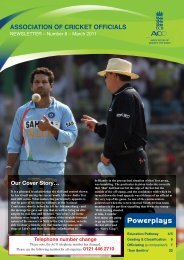


![Indoor Sports Halls with Cricket Provision [TS3] - Ecb - England and ...](https://img.yumpu.com/49070696/1/190x135/indoor-sports-halls-with-cricket-provision-ts3-ecb-england-and-.jpg?quality=85)

